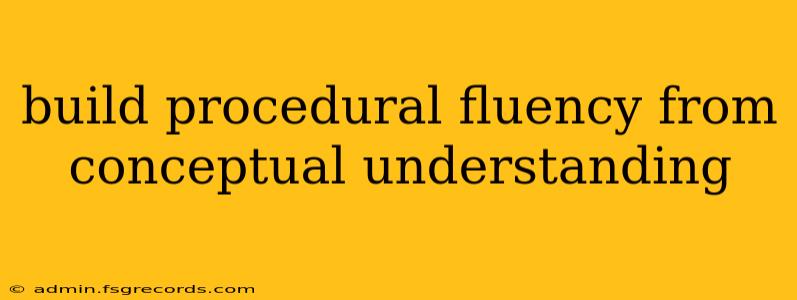Introduction:
In education, a critical goal is fostering not just the ability to solve problems, but the efficient and accurate execution of those solutions. This involves bridging the gap between conceptual understanding—knowing why a procedure works—and procedural fluency—knowing how to execute it swiftly and accurately. This post delves into effective strategies for building this crucial connection, benefiting students across all academic levels.
Understanding the Interplay: Conceptual Understanding and Procedural Fluency
Conceptual understanding refers to grasping the underlying principles, relationships, and meanings behind mathematical concepts or procedures. It's the "big picture" understanding—knowing why a mathematical operation works, not just how to perform it mechanically. Procedural fluency, on the other hand, is the ability to perform mathematical procedures accurately, efficiently, and flexibly. It's the ability to execute the "how-to" with speed and precision. The two are inextricably linked; strong conceptual understanding forms the foundation for robust procedural fluency.
Why the Connection Matters:
Students who lack conceptual understanding often struggle with procedural fluency. They may memorize procedures without understanding their purpose, leading to errors, inflexibility, and a lack of problem-solving ability when faced with unfamiliar situations. Conversely, a strong conceptual foundation allows for a deeper, more meaningful understanding of procedures, making them easier to learn, retain, and apply creatively.
Strategies for Building Procedural Fluency from Conceptual Understanding
Here are several evidence-based strategies teachers and students can employ:
1. Concrete to Abstract Progression:
Begin with hands-on activities and manipulatives. For example, when teaching multiplication, start with arranging objects in arrays to visually represent the concept before introducing the symbolic notation. This concrete experience builds a strong conceptual foundation before moving to abstract symbolic manipulation.
2. Meaningful Problem Solving:
Present problems that require students to apply their conceptual understanding to solve real-world or engaging scenarios. This helps students see the relevance of procedures and strengthens their understanding of when and how to apply them. Avoid rote exercises; focus on problem-solving that challenges their understanding.
3. Explicit Connections:
Teachers should explicitly connect the conceptual understanding to the procedure. For instance, when teaching long division, explain how each step aligns with the underlying concept of sharing or grouping. Making these connections clear helps students see the "why" behind the "how."
4. Strategic Practice:
Practice is crucial, but it shouldn't be mindless repetition. Focus on strategic practice—exercises designed to target specific areas of difficulty or reinforce crucial concepts. This includes spaced repetition, varied practice problems, and opportunities for self-assessment.
5. Error Analysis and Reflection:
Encourage students to analyze their mistakes and reflect on their understanding. Errors aren't failures; they're opportunities for learning. By analyzing their errors, students can pinpoint misconceptions and strengthen their conceptual understanding, ultimately improving procedural fluency.
6. Use of Technology:
Interactive simulations and educational games can provide engaging and effective ways to practice procedures while reinforcing conceptual understanding. These tools can offer immediate feedback, allowing students to learn from their mistakes in a supportive environment.
Assessing Procedural Fluency with Understanding
Assessments should move beyond simple procedural tests. Include problems that require students to explain their reasoning, justify their choices, and apply their knowledge to novel situations. This holistic assessment approach accurately reflects the level of both procedural fluency and conceptual understanding.
Conclusion: A Synergistic Relationship
Building procedural fluency from conceptual understanding is not a linear process; it's a synergistic relationship where each component strengthens the other. By implementing these strategies, educators can effectively guide students towards a deeper and more meaningful understanding of mathematics, leading to increased confidence, accuracy, and efficiency in problem-solving. The ultimate aim is to empower students to become confident, adaptable, and strategic mathematicians.

